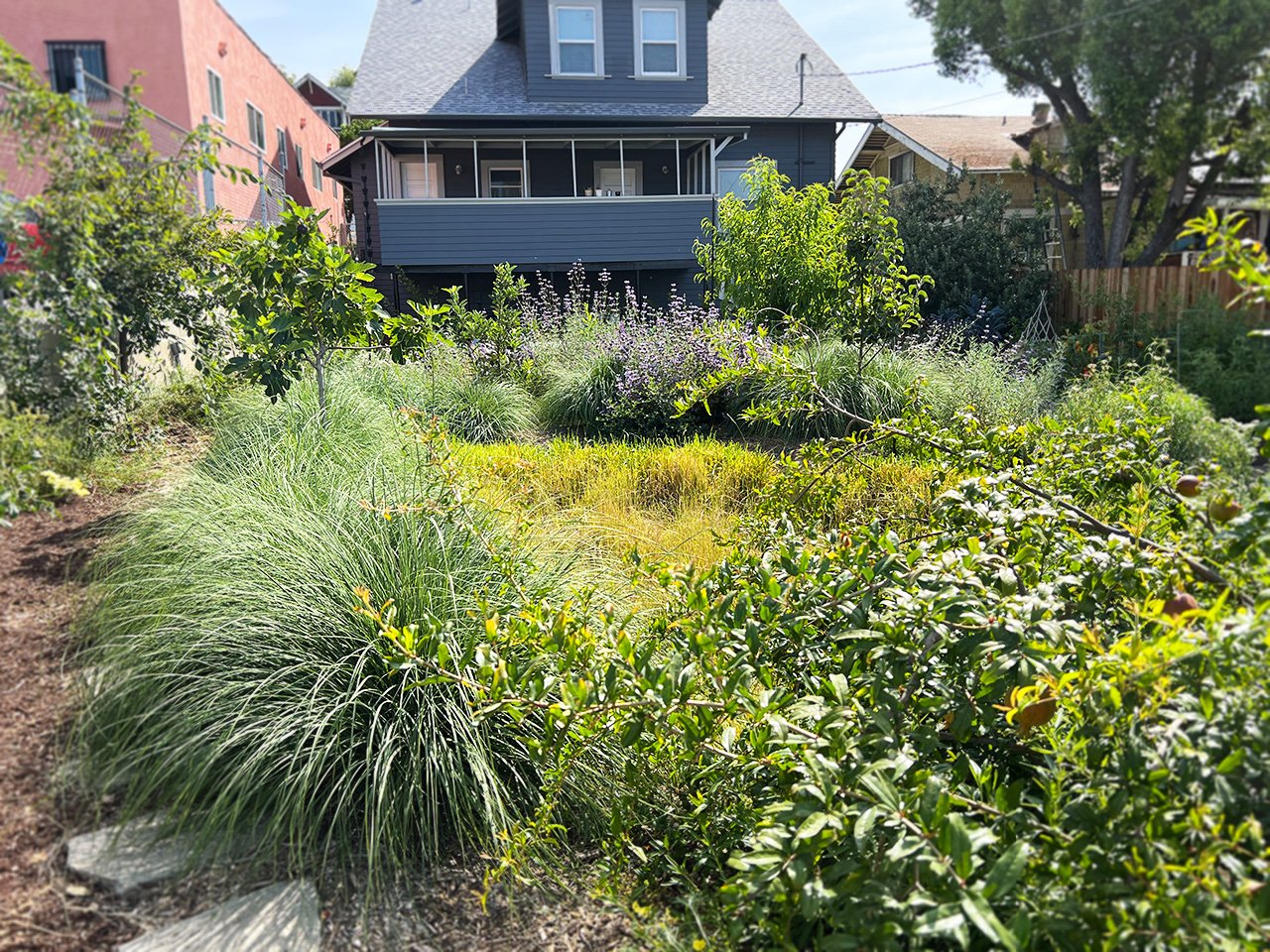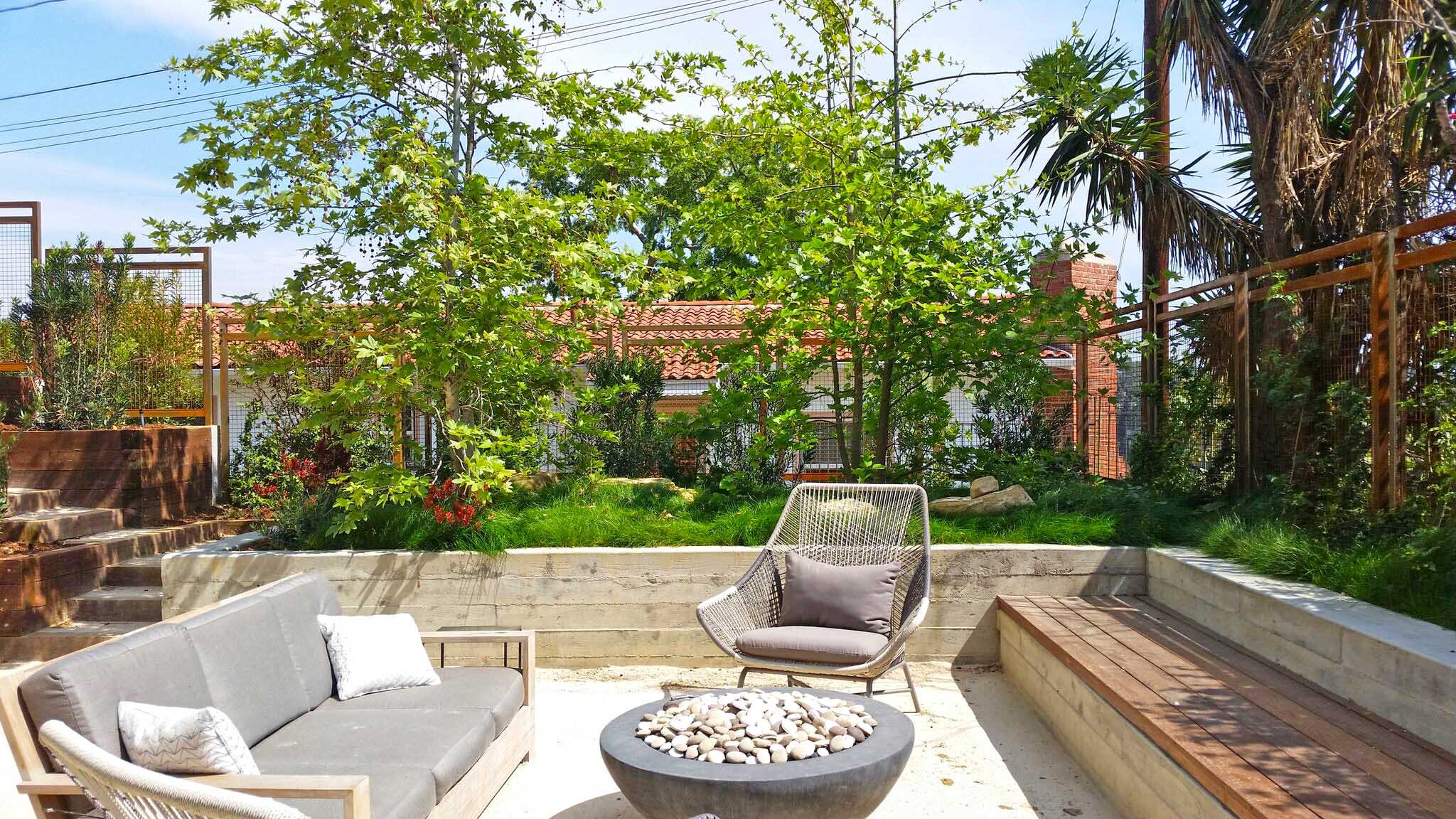Landscape Design for Greywater
As with any landscape design, many factors will affect the growth of your plants when irrigating with greywater. With or without greywater, placement is key. It will determine how much sun, water and exposure to the elements the plants receive, and will also condition how greywater interacts with the landscape in some areas of your garden versus others.
Greywater is a non-traditional form of irrigation that must be approached differently in many ways. Think of a greywater system like a spring on your property that provides a steady flow of water with seasonal ups and downs. We work with untreated greywater because it makes for simpler, more reliable systems; but this means the water cannot be stored and must be used as soon as it is generated. It also means it must be delivered into mulch basins, which are trenches about a foot deep filled with woodchip mulch. The size of the basins depends on the amount of greywater generated in your home and the drainage rate of the soil.
A greywater system doesn’t always mean individual plants are getting a lot of water. Flow rate, distribution area and irrigation tuning all come into play when determining how much water different plants throughout the landscape will get.
Mulch basin from above: the irrigation lines are buried and the emitter is covered with the shield on the left.
Targeted Irrigation
Mulch basins and plantings are sized proportionately to the amount of greywater they will receive, and their location has a direct impact on how a given amount of water will affect the landscape. Cool, shaded areas will stay moist longer than sunny areas that tend to dry out; and greywater delivered high up on slopes will tend to filter down, while accumulating in low-lying spots. For these reasons, greywater is particularly good as supplemental irrigation, or for targeted irrigation of key plants within a low water landscape.
A low-water garden complete with rain swales, drought tolerant native plants and targeted irrigation of fruit trees with greywater.
Mulch basins are generally placed under the dripline of the plants they will irrigate. New plantings should be left room to grow in, avoiding the need to re-dig the basins further back over time. Basin placement can be adjusted based on how the plantings are responding, as can flow to individual basins with adjustable ball valves on the ends of our irrigation emitters.
What can you grow on greywater?
Greywater is ideal for deep watering of many varieties of fruit trees, shade trees and larger ornamentals, although it can also be used to target zones of smaller plants. It is not ideal for vegetables but it can work. It doesn’t work for groundcover, and should never be used on food that grows on or beneath the ground such as potatoes, lettuce or carrots, because they may come in direct contact with the greywater.
Fruit trees
Southern California is a region with enough microclimates that we have seen countless varieties of fruit trees thriving on greywater. Coastal vs. valley, north vs. south facing slopes, elevation… Much of a tree’s success is site and care specific, but as with most plants an adequate supply of greywater will drive rapid growth and production thanks to the consistent deep watering and nutrients it delivers.
For outlets that deliver large amounts of greywater or areas that tend to stay wet, many varieties of apples, pears, mango, persimmon, mulberry and grafted citrus can tolerate wet to flooded conditions. Limes are also known to withstand periods of flooding, and we have witnessed bananas thriving on greywater in some of the warmer micro-pockets of our city (source).
In our experience, peach and avocado, while not especially thirsty, can be incredibly productive and fast-growing with the right amount of greywater. The same goes for lemon trees, which are known to hate “wet feet”, but work when greywater supply is low or other factors make for less humid soil conditions. For fruit trees that are sensitive to moist conditions, placing mulch basins further back or downhill from the tree can be effective strategies to get them the right amount of water.
Pomegranate! Can you spot the greywater emitter?
Shade trees
The same considerations apply with shade trees as with fruit trees. Check water needs for select species and take into account how conditions like sun exposure, drainage, and basin placement will affect your trees’ water needs. We have seen a very wide range of trees growing happily on greywater, and design systems with their needs in mind. Factors like soil type, slope (steepness, orientation, location), sun, drainage and more all come into play, but again, the steady supply of deep watering and organic matter seems to agree with most established trees.
Riparian natives
From an ecological standpoint, the best thing you can plant in your garden are species that are endemic to California and more specifically the corner of California where you are planting. Many natives are adapted to low moisture and don’t require greywater to thrive, but many species, especially from the riparian biome, can use the extra water.
Starting with shade trees, we have to name our favorite first, the California Sycamore. These can be found all over LA where the water flows and, of course, rapidly reaching for the sky near strategically placed greywater emitters. California Box Elder and Big Leaf Maple are also among the long list of native trees that like water. There are many smaller plant options as well, such as California Grape and Desert Columbine, which does well in alkaline soils.
California Sycamores grow quickly on abundant, nutrient-rich greywater.
Ph of Greywater
This last point leads us to considerations on the pH of greywater. We have not measured pH directly, but different studies have concluded that it depends more on the water itself, and if anything tends to skew slightly alkaline:
“The pH in greywater to a large extent depends on the pH and alkalinity in the water supply and normally is within the range of 5–9. Greywater with most of its sources originating from the laundry will generally exhibit high pH due to the presence of alkaline materials used in detergents.”
Worth noting is that the decomposing woodchips in the mulch basins skew acidic, which tends to compensate for the alkalinity of greywater.
Get planting!
As with many garden endeavors, trial and error will inevitably come into play. Greywater isn’t any different. For any species you are looking to grow, many location-based factors such as sun, slope, drainage and microclimate will affect the outcome. The greywater system should be designed and tuned to serve the plants, and there is significant leeway to adapt greywater to a range of options for your landscape.





